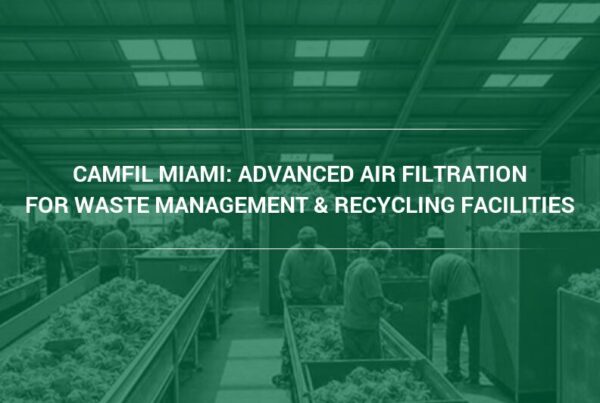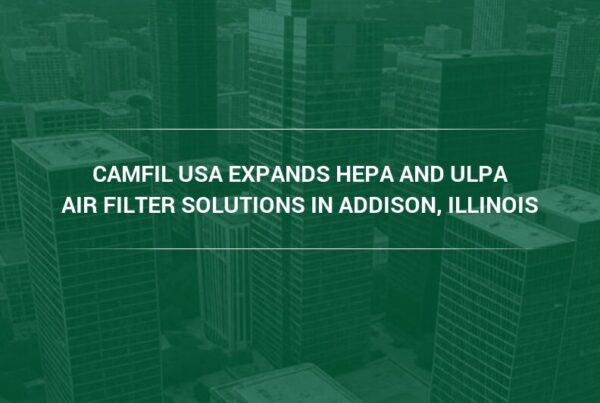Cross-state air pollution is an environmental challenge that is one of the many factors driving demand for our commercial air filters.
On July 6, 2011, the United States Environmental Protection Agency (EPA) implemented the Cross-State Air Pollution Rule (CSAPR) in an effort to address the problem of power plant emissions from upwind states that cross state lines and reduce air quality in downwind states.
The rule highlights the often-unexpected consequences of air pollution. Pollutants from major metropolitan cities, for example, can travel for hundreds of miles, carrying sulfur dioxide (SO2) and nitrogen oxides (NOx), which combine with the atmosphere to create soot, acid rain, and ground-level ozone.
“The CSAPR requires states, particularly those in the eastern half of the United States, to take action and improve air quality by cutting power plant emissions that cross state lines, increasing smog and soot levels in downwind states,” says Camfil USA’s Charlie Seyffer, Manager of Marketing & Technical Materials for commercial air filters and 37-year ASHRAE member and active committee participant. “The CSAPR forces states identified to be major sources of pollution to be held accountable for their own mess, rather than place the burden of cleaning up on downwind states.”
These protections, however, are at risk of being rolled back by no less than the EPA itself. Under a new administration, the EPA published a memo in January this year providing a new guidance that allows a “major source” of air pollution to re-designate themselves as an “area source” if they can bring down their air emissions to area source standards.¹
“This rating system creates a loophole to stop using environment-friendly equipment and continue reducing their emissions after they get to the area source level,” points out Seyffer.
But what does all this mean for us and the air quality in buildings and homes?
Air Pollution is Generating a Need for Air Purification Systems
While evidence of the problem of cross-state air pollution can be confirmed by measuring the volume of hazardous particulate matter in the air, air pollution has an even more insidious effect—one that raises the importance of using air purification systems in our homes and buildings.
In 2016, a U.S. study found that women who breathe polluted air in the weeks leading up to or after they get pregnant face a higher risk of giving birth to infants with birth defects. Researchers collected data from more than 290,000 babies with congenital issues born in Ohio between 2006 and 2010 and matched these records with the air pollution measurements in their mothers’ homes.²
The researchers focused on PM2.5, or particulate matter smaller than 2.5 microns in size, which is commonly created by car exhaust and is primarily composed of smoke, dirt, dust, and soot. They found that women who were exposed to higher levels of PM2.5 in the weeks before or after their pregnancy were associated with “meaningful increased risk” of congenital defects.
How Does Cross-State Air Pollution Affect Indoor Air Quality?
While the main causes of indoor air quality issues are inefficient fuel combustion from cooking, heating, and lighting, as well as natural indoor air pollutants like fumes from building materials and cleaning products, outdoor air pollution can be just as significant a contributor to the problem.
This is especially true in highly ventilated buildings or homes in cities and neighborhoods bearing the brunt of air pollution. What usually happens is outside, contaminated air penetrates the enclosed space through open doors, windows, and even small cracks in walls, floors, and ceilings.
How Are Air Filter Manufacturers Fighting the Problem?
Because regular heating, ventilation, and air conditioning (HVAC) systems only stir up indoor air, moving it from room to room and from the outside in, buildings have turned to air filter manufacturers to provide high efficiency filtration systems designed for schools, commercial buildings, manufacturing centers, retail establishments, and healthcare facilities among many others.
“High efficiency air filters are essentially devices that remove solid particulate matter and molecular contaminants to improve indoor air quality,” said Seyffer.
Air filtration systems typically use some kind of filter media held by a frame and sealed to prevent leaks between the frame and media so all of the air is filtered by the system. Filter systems may also feature a:
- Faceguard – This protects the filter media during transport and handling
- Gasket – This prevents leaks between the frame and its housing
While many air filters share similar components and characteristics, the filters and filter media themselves may be constructed in a wide variety of ways, depending on the desired effectiveness of the filtration system and its intended application. You can expect to see these systems in the form of bags, cartridges, panels and mats.
Classification of Air Filter Systems
Air filter systems usually fall into three primary categories based on their method of filtration.
- Mechanical Filtration – Mechanical filters capture contaminants the way a sifter separates food ingredients into larger and smaller pieces. These filters, in turn, use three different methods of mechanical filtration:
-
- Straining – As the name suggests, this method works by capturing contaminant particles larger than the gap between the filter media’s fibers. This action is especially effective for filtering large particles like lint, dust, and hair.
- Interception – This action uses a molecular phenomenon called Van der Waals force to attract particles following the air stream, ultimately contacting the filter media causing them to stick on the filter media.
- Diffusion – This action is most effective for particles as small as 0.3 microns in size and is commonly used by high efficiency particulate air (HEPA) filters and ultra-low particulate air (ULPA) filters to trap airborne contaminants in a highly porous media. These are the most efficient filters you can buy although they may tax the HVAC system with higher pressure drop or possibly reduced airflow.
- Electrostatic Filtration – This method of filtration uses electrostatically-charged fibers to attract and trap airborne particulates. Typically using polypropylene or polyurethane filter medias, filter systems that depend on electrostatic filtration can have an efficiency rate of up to 96 percent when removing contaminants in the air. Unfortunately, due to the fibers becoming insulated with contaminants as the filter loads they can drop in efficiency over time.
- Electronic Filtration – Electronic filters use a series of electrodes placed inside a filter grid. When an electric current is passed through the electrodes, the particles that enter are positively charged and trapped within a disposable or reusable negatively-charged collector pad. Because these filters run on active systems that use electricity, they can be expensive to run and maintain.
Are Filters and Air Purification Systems the Answer to Cross-State Air Pollution?
While filters and air purification systems have been a tremendous asset to all kinds of organizations and facilities struggling with indoor air quality problems, these solutions only treat the symptoms of a larger problem—one requiring deeper intervention through effective governance, regulation, and public awareness. Air pollution can only be solved if the actual source of the pollution can be addressed. Anything else is akin to preventing a fire from spreading.
Still, air filter systems are better than having nothing to keep polluted air outside our homes and buildings. Remember that when choosing a commercial filter, brand expertise and specialization matters. Not all filter systems, after all, are built the same way, so be sure to work with a manufacturer you can trust—someone who’s willing to provide custom solutions depending on your air quality needs.
At Camfil USA, we believe in making cities safe against air pollution. To learn more about our industrial air filtration systems, please click here.
Lynne Laake
Camfil USA Air Filters
T: 888.599.6620
E:Lynne.Laake@camfil.com
F: Friend Camfil USA on Facebook
T: Follow Camfil USA on Twitter
Y: Watch Camfil Videos on YouTube
Sources:



